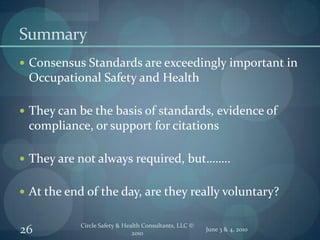Consensus Standards
- 1. Do You Need to Follow Them?Consensus StandardsAnna E. Jolly, JD, CHMM
- 2. What are they?Standards â Whether it has been promulgated by OSHA, MSHA, a state agency or a voluntary standards group, the purpose is to prevent employees from being exposed to a hazard.Voluntary Consensus Standard are those developed or adopted by voluntary consensus bodies through a process of logical and agreed-upon process.June 3 & 4, 20102Circle Safety & Health Consultants, LLC ÂĐ 2010
- 3. Why are they important?They reflect the opinions of safety and health professionals and other groups such as users and worker representatives, and academics in all levels of the public and private sector.They are systematically reviewed to keep them current.They are a valuable guideline or reference.June 3 & 4, 20103Circle Safety & Health Consultants, LLC ÂĐ 2010
- 4. Most Common Consensus BodiesANSI â American National Standards InstituteASTM- American Society of Testing and MaterialsNFPA â National Fire Protection AssociationNEC â National Electrical CodeACGIH â American Conference of Governmental Industrial HygienistsJune 3 & 4, 20104Circle Safety & Health Consultants, LLC ÂĐ 2010
- 5. History of Consensus Standards and OSHAAdoption during first 2 years of OSHA.5
- 6. Incorporation by Reference (PPE)1910.133(b)Criteria for protective eye and face protection.1910.133(b)(1) Protective eye and face protection devices must comply with any of the following consensus standards:1910.133(b)(1)(i) ANSI Z87.1-2003, "American National Standard Practice for Occupational and Educational Eye and Face Protection," which is incorporated by reference in § 1910.6;1910.133(b)(1)(ii) ANSI Z87.1-1989 (R-1998), "American National Standard Practice for Occupational and Educational Eye and Face Protection," which is incorporated by reference in § 1910.6; or1910.133(b)(1)(iii) ANSI Z87.1-1989, "American National Standard Practice for Occupational and Educational Eye and Face Protection," which is incorporated by reference in § 1910.6.1910.133(b)(2) Protective eye and face protection devices that the employer demonstrates are at least as effective as protective eye and face protection devices that are constructed in accordance with one of the above consensus standards will be deemed to be in compliance with the requirements of this section.June 3 & 4, 20106Circle Safety & Health Consultants, LLC ÂĐ 2010
- 7. Does OSHA use them for enforcement?Recognize that these are voluntary standards.But, sometimes they do and sometimes they donât.The OSHA Field Operations Manual (Sept. 2009) âThese private standards cannot be enforced as OSHA standards, but they may be used to provide evidence of industry recognition, seriousness of the hazard or feasibility of abatement methodsâ.June 3 & 4, 20107Circle Safety & Health Consultants, LLC ÂĐ 2010
- 8. 1. Development of New StandardsCongress issued the National Technology Transfer and Advancement Act of 1995 (NTTAA), 15 USC §272OMB Circular A â 119 (1998)Agencies must use unless inconsistent with law or otherwise impracticalAgencies must consult with consensus standards bodies and participate in standards development.May adopt only portions or incorporate by reference.June 3 & 4, 20108Circle Safety & Health Consultants, LLC ÂĐ 2010
- 9. 2. Di Minimis ConditionsWhere an employer has implemented a measure different than the one specified in the standard, that has no direct of immediate relationship to safety or health.If the employer complies with a proposed OSHA standard or amendment or a consensus standard that provides equal or greater employee protection.Documented but no citation issued.June 3 & 4, 20109Circle Safety & Health Consultants, LLC ÂĐ 2010
- 10. ExampleFixed industrial laddersStandard 1910.27(d)(2)Landings at 30 feet Proposed Standard: Walking & Working Surfaces (1990, 2003, 2010)Landings at 50 feetANSI â ASC A14.3 â 2008Landings at 50 feetJune 3 & 4, 201010Circle Safety & Health Consultants, LLC ÂĐ 2010
- 11. 3. General Duty Clause: 5(a)(1)29 USC 654 SEC. 5. Duties (a) Each employer --Â (1) shall furnish to each of his employees employment and a place of employment which are free from recognized hazards that are causing or are likely to cause death or serious physical harm to his employees;June 3 & 4, 201011Circle Safety & Health Consultants, LLC ÂĐ 2010
- 12. Elements of the Violationâš The employer failed to keep the workplace free of a hazard to which employees of that employer were exposed; âš The hazard was recognized; âš The hazard was causing or was likely to cause death or serious physical harm; and âš There was a feasible and useful method to correct the hazard. June 3 & 4, 201012Circle Safety & Health Consultants, LLC ÂĐ 2010
- 13. Nuances of General DutyHazards cited must present the possibility of death or great bodily harmExposure of the cited employerâs own employeesUsed only where no existing OSHA standard applies to the particular hazard June 3 & 4, 201013Circle Safety & Health Consultants, LLC ÂĐ 2010
- 14. What is the role of the consensus standard?Evidence that the hazard is recognized in the industryEvidence of the seriousness of the hazardFeasibility of the abatement methodsJune 3 & 4, 201014Circle Safety & Health Consultants, LLC ÂĐ 2010
- 15. 4. Use in Tort CasesFrequently used to establish the âstandard of careâ in litigation.OSHAâs use of the consensus standard gives it more weight.June 3 & 4, 201015Circle Safety & Health Consultants, LLC ÂĐ 2010
- 16. General Industry ExamplesJune 3 & 4, 201016Circle Safety & Health Consultants, LLC ÂĐ 2010
- 17. National Fire Protection Association 70EHas not been adopted by OSHAWhen a serious shock or arc-flash incident 1910.335(a)(1)(i) for PPE 1910.132(d)(1) for PPE assessmentsGeneral duty clauseJune 3 & 4, 201017Circle Safety & Health Consultants, LLC ÂĐ 2010
- 18. ANSI/ASSE Z244.1-2003 Control of Hazardous Energy â Lockout Tagout1910.147Can be used as a guideEnergy control proceduresParts are considered not as effectiveAlternative methodsTagout useJune 3 & 4, 201018Circle Safety & Health Consultants, LLC ÂĐ 2010
- 19. ANSI B11.3: Safety Requirements for Power Press BrakesHazard: GUARDINGSection 5(a)(1) of the Occupational Safety and Health Act of 1970: a) Shop - The points of operation of press brakes were not protected by guards or guarding devices. As an alternative, the employer had not developed and implemented a safe distance program. On or about 03/01/2010. NOTE: One feasible abatement method would be to develop and implement a safe distance program that complies with the requirements of ANSI B11.3-1982 and OSHA Directive CPL 2-1.25. June 3 & 4, 201019Circle Safety & Health Consultants, LLC ÂĐ 2010
- 20. NFPA 654 - 2006: Standard for the Prevention of Fires and Dust Explosions âĶ.Hazard: DUST&FUMESNorth Carolina General Statute 95-129(1) of the Occupational Safety: Employees were exposed to an explosion hazard due an accumulation of dust/powder produced during rubber processing at mixing area from dust/powder containing carbon black, sulfur and other synthetic rubber manufacturing materials, including but not limited to, HRJ-2765 (thermoplastic phenolic resin), OT TMTD (thiram), zinc oxide and Crystex HD OT 20, during the mixing process. Among other methods of abatement, one feasible method would be to follow the guidelines laid out in the National Fire Protection Association (NFPA) 654, Standard for the Prevention of Fires and Dust Explosions from the Manufacturing, Processing and Handling of Combustible Particulate Solids (2006 Edition.) June 3 & 4, 201020Circle Safety & Health Consultants, LLC ÂĐ 2010
- 21. Construction ExamplesJune 3 & 4, 201021Circle Safety & Health Consultants, LLC ÂĐ 2010
- 22. ANSI B30.5-1968: Mobile and Locomotive CranesHazard: STRUCK BYSection 5(a)(1) of the Occupational Safety and Health Act of 1970: (a)Highway 32, Water Valley, MS - On or about March 18, 2010 the employer did not ensure that the load hook, ball assembly and load block used by an American Crawler Crane to lift a 5200 pound concrete bucket was equipped with a latch for the hook and a label with rated capacity and weight. One feasible and used abatement method for correcting this hazard, among others, is to, comply with American National Standard (ANSI/ASME B30.5b - 1985) for Mobile and Locomotive Cranes, paragraph 5-1.7.6: All hook and ball assemblies and load blocks shall be labeled with their rated capacity and weight. Hooks shall be equipped with latches. June 3 & 4, 201022Circle Safety & Health Consultants, LLC ÂĐ 2010
- 23. ANSI A14.4-1992: Job Made Wooden LaddersHazard: FALLINGSection 5(a)(1) of the Occupational Safety and Health Act of 1970: New Design Construction did not ensure that employees were protected from fall hazards, in that employees used a job made wooden ladder without the filler blocks inserted between the cleats. Among other methods one feasible and acceptable abatement method to correct this hazardous condition would be to develop and implement procedures and training, in accordance with ANSI A14.4-1992, for proper job made wooden ladders. June 3 & 4, 201023Circle Safety & Health Consultants, LLC ÂĐ 2010
- 24. ANSI /SAI A92.6: Self-Propelled Elevating Work PlatformsHazard: FALLINGSection 5(a)(1) of the Occupational Safety and Health Act of 1970: On or about January 14, 2010, and at times thereto, at the work-site located at 611 Columbia Street in Helena, Arkansas, employees working from a self-propelled elevating work platform [Upright Model XRT 33 S/N 2810] were exposed to injuries from falls should the scissor lift malfunction causing a collapse, overturn or other adverse action because the employer/user did not ensure or cause an annual inspection to be performed on the lift prior to use. One feasible method of abatement, among others is to ensure or cause annual inspections to be performed in accordance with Section 6.7, ANNUAL INSPECTION of the American National Standard Institute, ANSI/SIA A92.6-1999.June 3 & 4, 201024Circle Safety & Health Consultants, LLC ÂĐ 2010
- 25. ANSI/ASME B56.6: Safety Standard for Rough Terrain Forklift TrucksHazard: LIFTINGSection 5(a)(1) of the Occupational Safety and Health Act of 1970. On or about March 15, 2010, an employee working on a commercial building on the north side was exposed to fall hazards at a height of up to approximately 6 feet by standing on the forks of a forklift to remove a lifting strap off a beam. Among other methods, one feasible and acceptable means to abate this hazard is to use a work platform that is designed in accordance with American Society of Mechanical Engineers ANSI/ASME B56.6-6-2002, Safety Standards for Rough Terrain Forklift Trucks. June 3 & 4, 201025Circle Safety & Health Consultants, LLC ÂĐ 2010
- 26. SummaryConsensus Standards are exceedingly important in Occupational Safety and HealthThey can be the basis of standards, evidence of compliance, or support for citationsThey are not always required, butâĶâĶ..At the end of the day, are they really voluntary?June 3 & 4, 201026Circle Safety & Health Consultants, LLC ÂĐ 2010
- 27. Any QuestionsJune 3 & 4, 201027Circle Safety & Health Consultants, LLC @ 2010

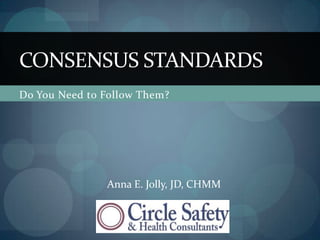
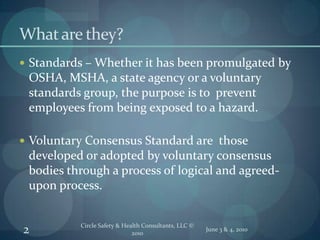

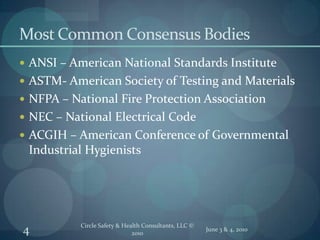

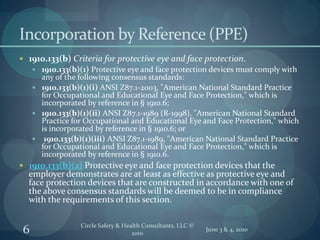

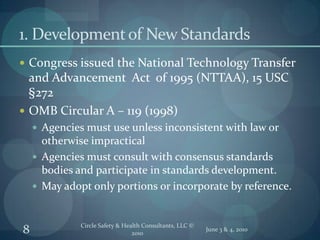






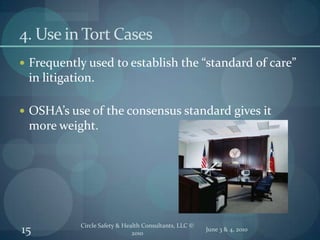








![ANSI /SAI A92.6: Self-Propelled Elevating Work PlatformsHazard: FALLINGSection 5(a)(1) of the Occupational Safety and Health Act of 1970: On or about January 14, 2010, and at times thereto, at the work-site located at 611 Columbia Street in Helena, Arkansas, employees working from a self-propelled elevating work platform [Upright Model XRT 33 S/N 2810] were exposed to injuries from falls should the scissor lift malfunction causing a collapse, overturn or other adverse action because the employer/user did not ensure or cause an annual inspection to be performed on the lift prior to use. One feasible method of abatement, among others is to ensure or cause annual inspections to be performed in accordance with Section 6.7, ANNUAL INSPECTION of the American National Standard Institute, ANSI/SIA A92.6-1999.June 3 & 4, 201024Circle Safety & Health Consultants, LLC ÂĐ 2010](https://image.slidesharecdn.com/consensusstandards-12832238778649-phpapp01/85/Consensus-Standards-24-320.jpg)

